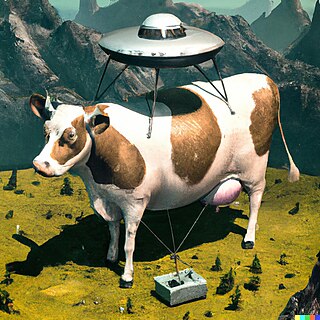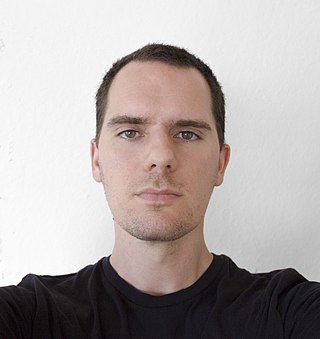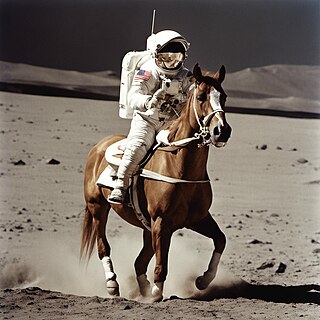
Digital art refers to any artistic work or practice that uses digital technology as part of the creative or presentation process. It can also refer to computational art that uses and engages with digital media.

Computer-generated imagery (CGI) is a specific-technology or application of computer graphics for creating or improving images in art, printed media, simulators, videos and video games. These images are either static or dynamic. CGI both refers to 2D computer graphics and 3D computer graphics with the purpose of designing characters, virtual worlds, or scenes and special effects. The application of CGI for creating/improving animations is called computer animation, or CGI animation.
Google Brain was a deep learning artificial intelligence research team under the umbrella of Google AI, a research division at Google dedicated to artificial intelligence. Formed in 2011, Google Brain combined open-ended machine learning research with information systems and large-scale computing resources. The team has created tools such as TensorFlow, which allow for neural networks to be used by the public, with multiple internal AI research projects. The team aims to create research opportunities in machine learning and natural language processing. The team was merged into former Google sister company DeepMind to form Google DeepMind in April 2023.
Picsart is an Armenian-American technology company based in Miami, Florida and Yerevan, Armenia that develops the Picsart suite of online photo and video editing applications, with a social creative community. The platform allows users to take and edit pictures and videos, draw with layers, and share the images on Picsart and other social networks. It is one of the world's most popular apps, with reportedly more than 1 billion downloads across 180 countries.
Deepfakes are synthetic media that have been digitally manipulated to replace one person's likeness convincingly with that of another. Deepfakes are the manipulation of facial appearance through deep generative methods. While the act of creating fake content is not new, deepfakes leverage powerful techniques from machine learning and artificial intelligence to manipulate or generate visual and audio content that can more easily deceive. The main machine learning methods used to create deepfakes are based on deep learning and involve training generative neural network architectures, such as autoencoders, or generative adversarial networks (GANs). In turn the field of image forensics develops techniques to detect manipulated images.

StyleGAN is a generative adversarial network (GAN) introduced by Nvidia researchers in December 2018, and made source available in February 2019.

Artificial intelligence art is any visual artwork created through the use of artificial intelligence (AI) programs.
Synthetic media is a catch-all term for the artificial production, manipulation, and modification of data and media by automated means, especially through the use of artificial intelligence algorithms, such as for the purpose of misleading people or changing an original meaning. Synthetic media as a field has grown rapidly since the creation of generative adversarial networks, primarily through the rise of deepfakes as well as music synthesis, text generation, human image synthesis, speech synthesis, and more. Though experts use the term "synthetic media," individual methods such as deepfakes and text synthesis are sometimes not referred to as such by the media but instead by their respective terminology Significant attention arose towards the field of synthetic media starting in 2017 when Motherboard reported on the emergence of AI altered pornographic videos to insert the faces of famous actresses. Potential hazards of synthetic media include the spread of misinformation, further loss of trust in institutions such as media and government, the mass automation of creative and journalistic jobs and a retreat into AI-generated fantasy worlds. Synthetic media is an applied form of artificial imagination.

Ai-Da is a robotic art exhibition created by British artist Aidan Meller, which has been described by its creator as "the world's first ultra-realistic humanoid robot". Completed in 2019, Ai-Da is an android incorporating computer graphics and artificial intelligence algorithms that makes drawings, paintings, and sculptures. It is named after Ada Lovelace.
Deepfake pornography, or simply fake pornography, is a type of synthetic porn that is created via altering already-existing pornographic material by applying deepfake technology to the faces of the actors. The use of deepfake porn has sparked controversy because it involves the making and sharing of realistic videos featuring non-consenting individuals, typically female celebrities, and is sometimes used for revenge porn. Efforts are being made to combat these ethical concerns through legislation and technology-based solutions.

Kyle McDonald is a media artist. McDonald creates visually appealing models using code, and releases tool kits for other artists to customize their own art as they see fit. McDonald was recently an adjunct professor at New York University Tisch School of the Arts' ITP. He is a member of F.A.T lab, and a community manager for OpenFrameworks. He was a resident at STUDIO for Creative Inquiry at Carnegie Mellon University.

15.ai is a non-commercial freeware artificial intelligence web application that generates natural emotive high-fidelity text-to-speech voices from an assortment of fictional characters from a variety of media sources. Developed by a pseudonymous MIT researcher under the name 15, the project uses a combination of audio synthesis algorithms, speech synthesis deep neural networks, and sentiment analysis models to generate and serve emotive character voices faster than real-time, particularly those with a very small amount of trainable data.

DALL·E, DALL·E 2, and DALL·E 3 are text-to-image models developed by OpenAI using deep learning methodologies to generate digital images from natural language descriptions, called "prompts."
Prequel, Inc. is an American technology company and mobile app developer known for developing the Prequel mobile application, which enables editing photos and videos with filters and effects generated using artificial intelligence. Prequel was founded in 2018 by Serge Aliseenko and Timur Khabirov, who currently serves as the company’s CEO. It is headquartered in New York City. As of August 2022, it had been downloaded more than 100 million times.

Midjourney is a generative artificial intelligence program and service created and hosted by the San Francisco–based independent research lab Midjourney, Inc. Midjourney generates images from natural language descriptions, called prompts, similar to OpenAI's DALL-E and Stability AI's Stable Diffusion. It is one of the technologies of the AI boom.

Stable Diffusion is a deep learning, text-to-image model released in 2022 based on diffusion techniques. It is considered to be a part of the ongoing AI boom.

Loab is a fictional character that artist and writer Steph Maj Swanson has claimed to have discovered with a text-to-image AI model in April 2022. In a viral Twitter thread, Swanson described it as an unexpectedly emergent property of the software, saying they discovered it when asking the model to produce something "as different from the prompt as possible".

NovelAI is an online cloud-based, SaaS model, and a paid subscription service for AI-assisted storywriting and text-to-image synthesis, originally launched in beta on June 15, 2021, with the image generation feature being implemented later on October 3, 2022. NovelAI is owned and operated by Anlatan, which is headquartered in Wilmington, Delaware.
In the 2020s, the rapid increase in the capabilities of deep learning-based generative artificial intelligence models, including text-to-image models such as Stable Diffusion and large language models such as ChatGPT, are posing questions of how copyright law applies to the training and use of such models. Because there is limited existing case law, experts consider this area to be fraught with uncertainty.

A ganimal, also commonly referred to as GANimal, is a hybrid animal created with generative artificial intelligence systems, such as generative adversarial networks (GANs) or diffusion models. The concept was created for a website from the MIT Media Lab in 2020, where users could create ganimal images. 78,210 ganimals were generated from hybrid pairs of animal labels from BigGAN (G1) and 3,058,362,945 ganimals generated from blending G1 ganimals.















